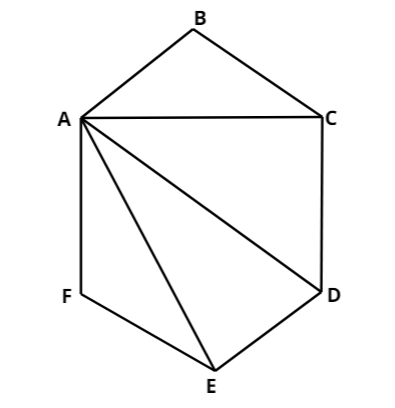
Consider a convex polygon which has $44$ diagonals then the number of triangles joining the vertices of polygon in which exactly one side is common in triangle and polygon is
Answer
569.4k+ views
Hint: As we know for a polygon of the side $n$, the total number of diagonals is given by $\dfrac{{n(n - 3)}}{2}$
As we are given that the number of diagonals is $44$, then we can get the number of sides of the polygon. Now we can find the number of sides of the triangles.
Complete step-by-step answer:

We need to find the number of diagonals if the polygon contains \[n\] sides. Now let us suppose there is a hexagon $ABCDEF$ the from the point A the number of possible diagonals will be $3$
And there are a total of six points so the total diagonal $ = (6)(3) = 18$ but in this way we counted one diagonal twice.
For example from point A we have the diagonal AC and from point C also we have the same diagonal AC but these both are the same so need to be counted once only.
So the number of diagonals $ = \dfrac{{(3)(6)}}{2} = 9$
Similarly for the square
Total number of diagonals $ = \dfrac{{1\left( 4 \right)}}{2}$
Similarly for polygon of side n we can write
Total number of diagonals $ = \dfrac{{n(n - 3)}}{2}$
Where n is the sides of the polygon.
So here we are given that there are $44$ diagonals in the polygon.
Then $\dfrac{{n(n - 3)}}{2} = 44$
$\Rightarrow$${n^2} - 3n - 88 = 0$
Upon solving we get
$\Rightarrow$${n^2} - 11n + 8n - 88 = 0$
$\Rightarrow$$n(n - 11) + 8(n - 11) = 0$
$\Rightarrow$$(n - 11)(n + 8) = 0$
So $n = 11, - 8$
$n$ cannot be negative so the polygon has $11$ sides
So the number of triangles can be formed having one side common to the polygon is given as
$
= n(n - 4) \\
= 11(11 - 4) \\
= 11(7) \\
= 77 \\
$
So $77$ possible triangles can be formed.
Note: Number of triangles formed by joining the vertices of n sided polygon which has no side in common with that of the polygon is given by $\dfrac{{n(n - 4)(n - 5)}}{{3!}}$ where n is the side of the polygon.
As we are given that the number of diagonals is $44$, then we can get the number of sides of the polygon. Now we can find the number of sides of the triangles.
Complete step-by-step answer:

We need to find the number of diagonals if the polygon contains \[n\] sides. Now let us suppose there is a hexagon $ABCDEF$ the from the point A the number of possible diagonals will be $3$
And there are a total of six points so the total diagonal $ = (6)(3) = 18$ but in this way we counted one diagonal twice.
For example from point A we have the diagonal AC and from point C also we have the same diagonal AC but these both are the same so need to be counted once only.
So the number of diagonals $ = \dfrac{{(3)(6)}}{2} = 9$
Similarly for the square
Total number of diagonals $ = \dfrac{{1\left( 4 \right)}}{2}$
Similarly for polygon of side n we can write
Total number of diagonals $ = \dfrac{{n(n - 3)}}{2}$
Where n is the sides of the polygon.
So here we are given that there are $44$ diagonals in the polygon.
Then $\dfrac{{n(n - 3)}}{2} = 44$
$\Rightarrow$${n^2} - 3n - 88 = 0$
Upon solving we get
$\Rightarrow$${n^2} - 11n + 8n - 88 = 0$
$\Rightarrow$$n(n - 11) + 8(n - 11) = 0$
$\Rightarrow$$(n - 11)(n + 8) = 0$
So $n = 11, - 8$
$n$ cannot be negative so the polygon has $11$ sides
So the number of triangles can be formed having one side common to the polygon is given as
$
= n(n - 4) \\
= 11(11 - 4) \\
= 11(7) \\
= 77 \\
$
So $77$ possible triangles can be formed.
Note: Number of triangles formed by joining the vertices of n sided polygon which has no side in common with that of the polygon is given by $\dfrac{{n(n - 4)(n - 5)}}{{3!}}$ where n is the side of the polygon.
Recently Updated Pages
Master Class 9 Social Science: Engaging Questions & Answers for Success

Master Class 9 Science: Engaging Questions & Answers for Success

Master Class 9 English: Engaging Questions & Answers for Success

Master Class 9 Maths: Engaging Questions & Answers for Success

Master Class 9 General Knowledge: Engaging Questions & Answers for Success

Class 9 Question and Answer - Your Ultimate Solutions Guide

Trending doubts
Which places in India experience sunrise first and class 9 social science CBSE

Fill the blanks with the suitable prepositions 1 The class 9 english CBSE

Write the 6 fundamental rights of India and explain in detail

Difference Between Plant Cell and Animal Cell

What is the Full Form of ISI and RAW

What is pollution? How many types of pollution? Define it




